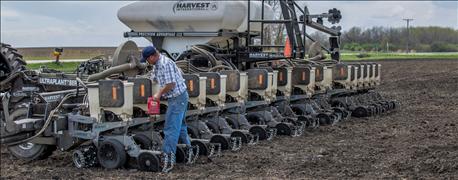
Could 20-inch corn yield higher than 30-inch corn? Two years of study at Beck’s Hybrids Practical Farm Research says it’s a real possibility.
Beck’s Jason Webster kicked off a three-year study on narrow-row corn this spring. He wants to help farmers gain a better understanding of 20-inch row corn yield benefits and management practices.
A custom-built planter is at the heart of the study. Harvest International manufactured the 40-foot planter to create a “pure” head-to-head comparison: rows 1 through 12 are 30-inch rows and rows 13 through 18 are 20-inch rows.

NARROW CORN, HIGHER YIELD? Jason Webster, Beck’s Hybrids Practical Farm Research (PFR) Innovation Lead, says two years of PFR studies indicate 20-inch row corn has potential to produce higher yields than "status quo" 30-inch rows.
“There are certain corn hybrids that could give us a yield advantages if we go to narrow rows,” Webster explains. “With every pass with this planter, we can evaluate different hybrids at those two row widths and at different seeding rates.” The 20-inch row populations in the study range from 32,000 to 44,000 and 30-inch rows start at 28,000 and go up to 40,000. “We want to develop that bell curve and find out what’s too high, what’s too low, and what’s perfect in the middle,” Webster notes.
Webster says the challenge with narrow-row corn isn’t planting - it’s nutrient management. Through a system of monitors, Webster and his team will track canopy closure time, heat inside the canopy, as well as disease and insect pressure.
To gather this data, Beck’s Hybrids is partnering with several companies for equipment and monitoring systems: Precision Planting’s meters and monitors; Yetter’s residue management systems and Hagie’s sidedress bars. Webster plans to use multi-directional corn heads at harvest.
“I love the collaboration,” Webster says. “It’s a 12-month story; from what we do at planting, to fungicide, canopy, temperature and humidity. We’ll know so much more 12 months from now.”
This year’s side-by-side trial covers six locations in east central Illinois, including Ford, Livingston and Kankakee counties. “We want to walk before we run and see if it works,” Webster says. “We had to make sure the planter wouldn’t draft to one side and see if the monitor would control two row widths on one planter.”
Webster notes next year the study will move to areas where farmers have expressed further interest in 20-inch row corn.

TRIAL PLANTER: This 40-foot Harvester International planter provides a unique side-by-side perspective: rows 1-12 are 30-inch rows and rows 13-18 are 20-inch rows.
About the Author(s)
You May Also Like




